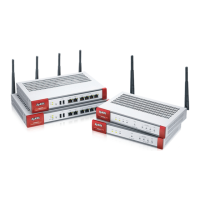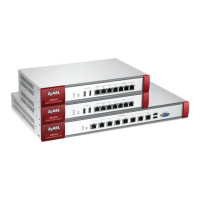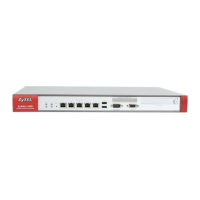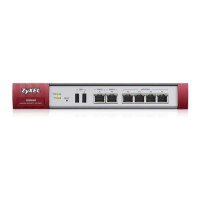Chapter 10 Interfaces
ZyWALL USG Series User’s Guide
399
Load Balancing
Index(es)
This field is available if you selected to use the Least Load First or Spillover method.
Select Outbound, Inbound, or Outbound + Inbound to set the traffic to which the Zyxel
Device applies the load balancing method. Outbound means the traffic traveling from an
internal interface (ex. LAN) to an external interface (ex. WAN). Inbound means the
opposite.
The table lists the trunk’s member interfaces. You can add, edit, remove, or move entries for
user configured trunks.
Add Click this to add a member interface to the trunk. Select an interface and click Add to add
a new member interface after the selected member interface.
Edit Select an entry and click Edit to modify the entry’s settings.
Remove To remove a member interface, select it and click Remove. The Zyxel Device confirms you
want to remove it before doing so.
Move To move an interface to a different number in the list, click the Move icon. In the field that
appears, specify the number to which you want to move the interface.
# This column displays the priorities of the group’s interfaces. The order of the interfaces in the
list is important since they are used in the order they are listed.
Member Click this table cell and select an interface to be a group member.
If you select an interface that is part of another Ethernet interface, the Zyxel Device does
not send traffic through the interface as part of the trunk. For example, if you have physical
port 5 in the ge2 representative interface, you must select interface ge2 in order to send
traffic through port 5 as part of the trunk. If you select interface ge5 as a member here, the
Zyxel Device will not send traffic through port 5 as part of the trunk.
Mode Click this table cell and select Active to have the Zyxel Device always attempt to use this
connection.
Select Passive to have the Zyxel Device only use this connection when all of the
connections set to active are down. You can only set one of a group’s interfaces to passive
mode.
Weight This field displays with the weighted round robin load balancing algorithm. Specify the
weight (1~10) for the interface. The weights of the different member interfaces form a ratio.
This ratio determines how much traffic the Zyxel Device assigns to each member interface.
The higher an interface’s weight is (relative to the weights of the interfaces), the more
sessions that interface should handle.
Ingress Bandwidth This is reserved for future use.
This field displays with the least load first load balancing algorithm. It displays the maximum
number of kilobits of data the Zyxel Device is to allow to come in through the interface per
second.
Note: You can configure the bandwidth of an interface in the corresponding
interface edit screen.
Egress Bandwidth This field displays with the least load first or spillover load balancing algorithm. It displays the
maximum number of kilobits of data the Zyxel Device is to send out through the interface
per second.
Note: You can configure the bandwidth of an interface in the corresponding
interface edit screen.
Spillover This field displays with the spillover load balancing algorithm. Specify the maximum
bandwidth of traffic in kilobits per second (1~1048576) to send out through the interface
before using another interface. When this spillover bandwidth limit is exceeded, the Zyxel
Device sends new session traffic through the next interface. The traffic of existing sessions
still goes through the interface on which they started.
The Zyxel Device uses the group member interfaces in the order that they are listed.
Table 132 Configuration > Network > Interface > Trunk > Add (or Edit) (continued)
LABEL DESCRIPTION

